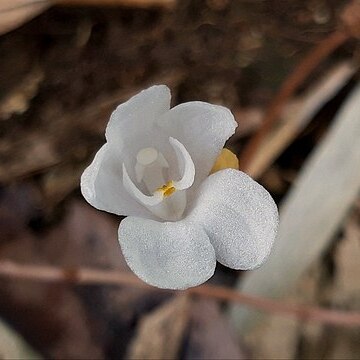Leafless terrestrial orchids with a fleshy root system consisting of slender, interconnected, elongated rhizomes with roots arising from apex; and pale, fleshy, brittle flower stems. Inflorescence racemose, flowers opening sequentially. Pedicels fleshy. Flowers short-lived (less than a day), bell-shaped, shedding completely from the flower stem soon after flowering unless pollinated. Basal parts of sepals and petals fused to form a tube with the apical parts separate and spreading widely. Labellum hinged to apex of short column foot. Labellum lamina unlobed, with a central keel carrying irregular rows of calli. Column slender with very short column foot. Anther with 4 pollinia attached directly to viscidium.
Leafless, achlorophylose, saprophytic herbs, with horizontal fleshy tubers. Stems erect, unbranched, slender. Inflorescences racemose, terminal, 1–many-flowered. Flowers small, fugacious, unspurred, white or cream. Tepals adnate at their bases forming a short tube, the adnate dorsal sepal and the petals forming the anterior ‘lip’ and the adnate lateral sepals forming the posterior ‘lip’. Lip often lobed, free from tepals, adnate to column-foot. Column elongated, widened at apex, with ± slender arms, and a column-foot; stigma near apex of column; another declinate; pollinia 4, without caudicle, occasionally bearing viscid disc. Pedicel lengthening very considerably as erect capsule matures.
Flowers small; tepals adnate at base forming a short tube; lip free from tepals, adnate to column foot.
Column long, wider at apex, with ± slender arms; stigma near apex; anther declinate.
Stems erect, unbranched; inflorescence terminal, racemose, 1 to many-flowered.
Leafless, saprophytic herb lacking chlorophyll; tubers fleshy, horizontal.
Pedicel elongating rapidly as capsule matures.
Pollinia 4, lacking caudicle.

